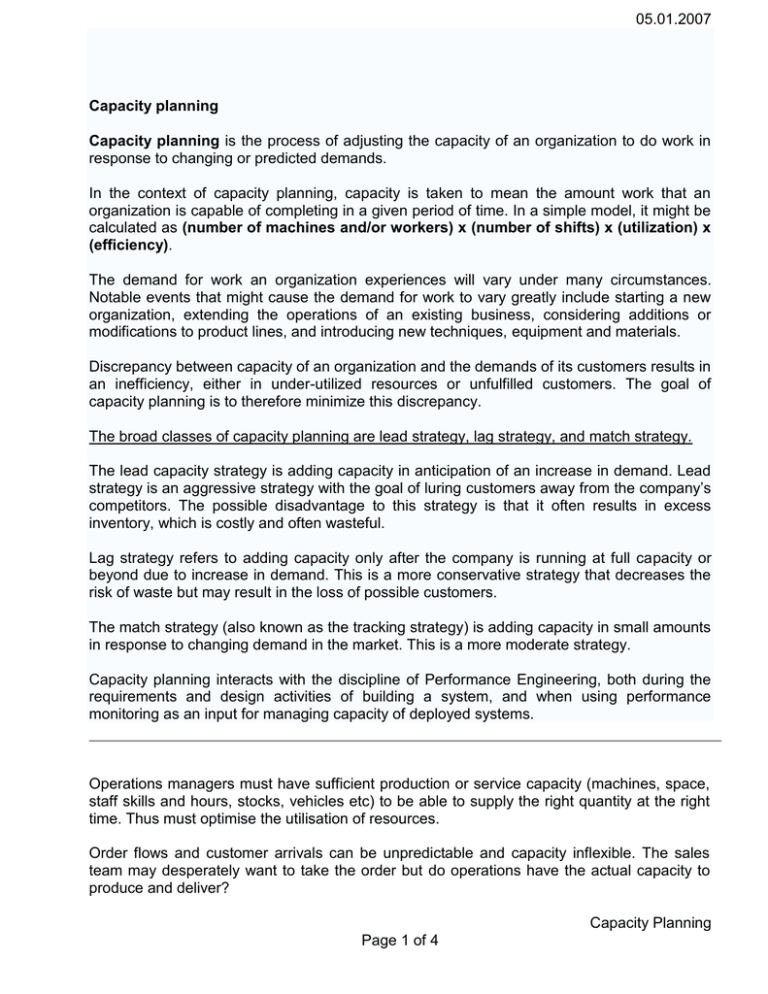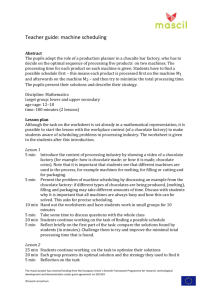05.01.2007 response to changing or predicted demands.
advertisement

05.01.2007 Capacity planning Capacity planning is the process of adjusting the capacity of an organization to do work in response to changing or predicted demands. In the context of capacity planning, capacity is taken to mean the amount work that an organization is capable of completing in a given period of time. In a simple model, it might be calculated as (number of machines and/or workers) x (number of shifts) x (utilization) x (efficiency). The demand for work an organization experiences will vary under many circumstances. Notable events that might cause the demand for work to vary greatly include starting a new organization, extending the operations of an existing business, considering additions or modifications to product lines, and introducing new techniques, equipment and materials. Discrepancy between capacity of an organization and the demands of its customers results in an inefficiency, either in under-utilized resources or unfulfilled customers. The goal of capacity planning is to therefore minimize this discrepancy. The broad classes of capacity planning are lead strategy, lag strategy, and match strategy. The lead capacity strategy is adding capacity in anticipation of an increase in demand. Lead strategy is an aggressive strategy with the goal of luring customers away from the company’s competitors. The possible disadvantage to this strategy is that it often results in excess inventory, which is costly and often wasteful. Lag strategy refers to adding capacity only after the company is running at full capacity or beyond due to increase in demand. This is a more conservative strategy that decreases the risk of waste but may result in the loss of possible customers. The match strategy (also known as the tracking strategy) is adding capacity in small amounts in response to changing demand in the market. This is a more moderate strategy. Capacity planning interacts with the discipline of Performance Engineering, both during the requirements and design activities of building a system, and when using performance monitoring as an input for managing capacity of deployed systems. Operations managers must have sufficient production or service capacity (machines, space, staff skills and hours, stocks, vehicles etc) to be able to supply the right quantity at the right time. Thus must optimise the utilisation of resources. Order flows and customer arrivals can be unpredictable and capacity inflexible. The sales team may desperately want to take the order but do operations have the actual capacity to produce and deliver? Capacity Planning Page 1 of 4 05.01.2007 Capacity planning methods vary according by industry or service yet many of the principles are similar. A long-term view may cover months to years. An operations strategy/policy is needed covering overall organisational capacity (production sites, hotels, hospital wings (rooms and beds), warehouses, production lines/machinery, computer up-grades and investment in new facilities etc Medium-term forecasting demand then scheduling available capacity to best meet or balance that demand. This typically involves manufacturing or requirements planning, machine scheduling, staffing rotas and materials requirements planning. These plans reflect different levels of aggregation. Short-term day-to-day adjustments are typical of capacity management. Our aggregate plans help in assigning production/service capacity to accommodate the demand but many details are only revealed in operation. Unforeseen contingencies occur by the hour, day or week. Local staff needs the expertise; discretion and some "slack" for flexibility to make locally identified adjustments - without upsetting the objectives of the aggregate plans. Capacity planning provides an operational framework and ensures the coordination of supplies and scheduling of resources. The starting points are: 1. Market information - do we know what the demand is and by when? Can we forecast (predict) it? 2. Shall we make goods to order only (MTO) or, being able to rely on a steady flow of orders with additional predictions of demand, make to stock (MTS)? Trends for both MTO and MTS must be predicted to ascertain capacity implications and generate plans. Capacity planning considerations Forecasting consider the differences between dependent and independent demand. Techniques of time series and estimating may be helpful. Pros and cons of chasing demand or producing to a level capacity... steady production to a given capacity level, massaging demand by marketing promotions, expanding/contracting capacity by overtime, part-time working, sub-contracting etc Planning Systems: methods aggregate planning e.g. master production schedules, materials requirements planning from forecast demand and bills of materials Planner-shop relationships etc. Linear Programming: a technique for specialist use. Capacity Planning Page 2 of 4 05.01.2007 Predictability and Contingencies To do capacity planning and scheduling planners must understand the limitations technology in use, staffing policies, the scope for contracting out, the implications organisation's size and structure etc. Plans can fail through staff illness, jobs unforeseen problems etc. Overtime may ease matters or a hire car may be offered customer - increasing costs - the customer may not be prepared to pay. of the of the hitting to the Consider the capacity difficulties in relation to perishables (newspapers, airline seats and meals). Overbooking by hoteliers can work to their advantage but can upset holidaymakers! Bus companies or airlines use fixed schedules - if planes are not filled at standard fares then bucket shops sell surplus seats. People stand in trains or wait angrily in the freezing cold for the next one. They will miss their connection and be late again for work A garage will book cars in for servicing according to equipment and staff availability "Sorry sir it will be Tuesday of next week at the earliest...” A telephone company or Internet Service Provider needs capacity to fit maximum demand (and growth) - office/college hours and weekend demand. Operational chnageovers and line repairs need to respond to existing demand. Fast operator/help desk systems may be needed at peak times. Public transport needs enough capacity for peak traffic. At other times buses and trains are idle. In production and operations management, three types of capacity are often referred to: The capacity that can be made available to influence the planning of senior management (e.g. in helping them to make decisions about overall Potential Capacity business growth, investment etc). This is essentially a long-term decision that does not influence day-to-day production management The amount of production capacity that can be made available in the Immediate Capacity short-term. This is the maximum potential capacity - assuming that it is used productively An important concept. Not all productive capacity is actually used or Effective Capacity usable. It is important for production managers to understand what capacity is actually achievable. Measuring capacity Capacity, being the ability to produce work in a given time, must be measured in the unit of work. For example, consider a factory that has a capacity of 10,000 " machine hours" in each 40 hour week. This factory should be capable of producing 10,000 "standard hours of work" during a 40-hour week. Capacity Planning Page 3 of 4 05.01.2007 The actual volume of product that the factory can produce will depend on: The amount of work involved in production (e.g. does a product require 1, 5, 10 standard hours? Any additional time required in production (e.g. machine set-up, maintenance) The productivity or effectiveness of the factory Constraints on capacity In capacity management there are usually two potential constraints - TIME and CAPACITY Time may be a constraint where a customer has a particular required delivery date. In this situation, capacity managers often "plan backwards". In other words, they allocate the final stage (operation) of the production tasks to the period where delivery is required; the penultimate task one period earlier and so on. This process helps identify whether there is sufficient time to meet the production demands and whether capacity needs to be increased, albeit temporarily. Production Scheduling A schedule is a representation of the time necessary to carry out a particular task. A job schedule shows the plan for the manufacture of a particular job. It is created through "work / study" reviews which determine the method and times required. Most businesses carry out several production tasks at one time - which entails amalgamating several job schedules. This process is called "scheduling". The result is known as the production schedule or factory schedule for the factory/plant as a whole. In preparing a production schedule, attention needs to be paid to: Delivery dates (when are finished products due?) Job schedules for each relevant production task. Capacities of production sections or departments involved. Efficiency of these production sections or departments. Planned holidays. Anticipated sickness / absenteeism / training. Availability of raw materials, components and packaging There are two key problems with production scheduling: (1) Measurement of performance (e.g. should financial performance be most important (e.g. minimise the amount of stock), or are marketing objectives more important - e.g. always produce enough to meet customer demand). (2) The large number of possible schedules - often caused by too much complexity or variety in the production needs of the business. Capacity Planning Page 4 of 4


